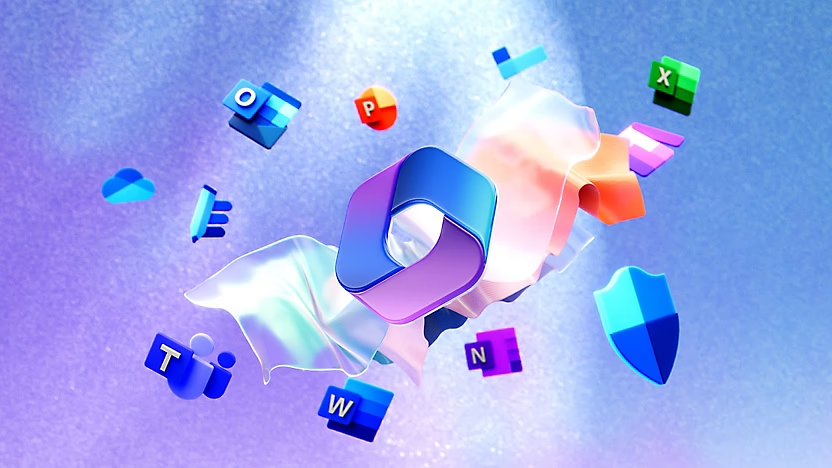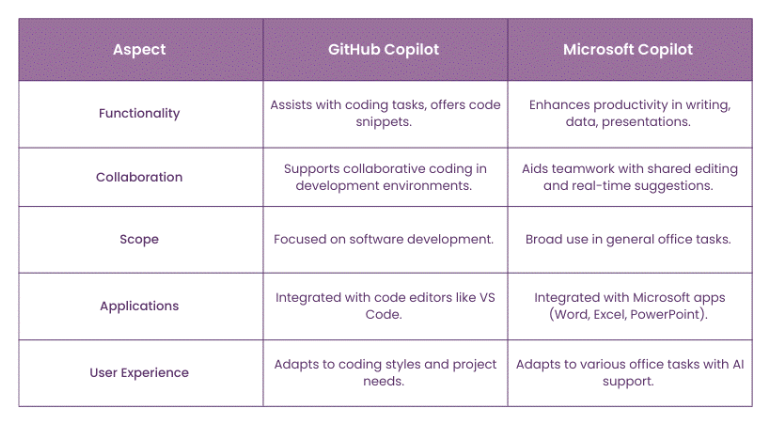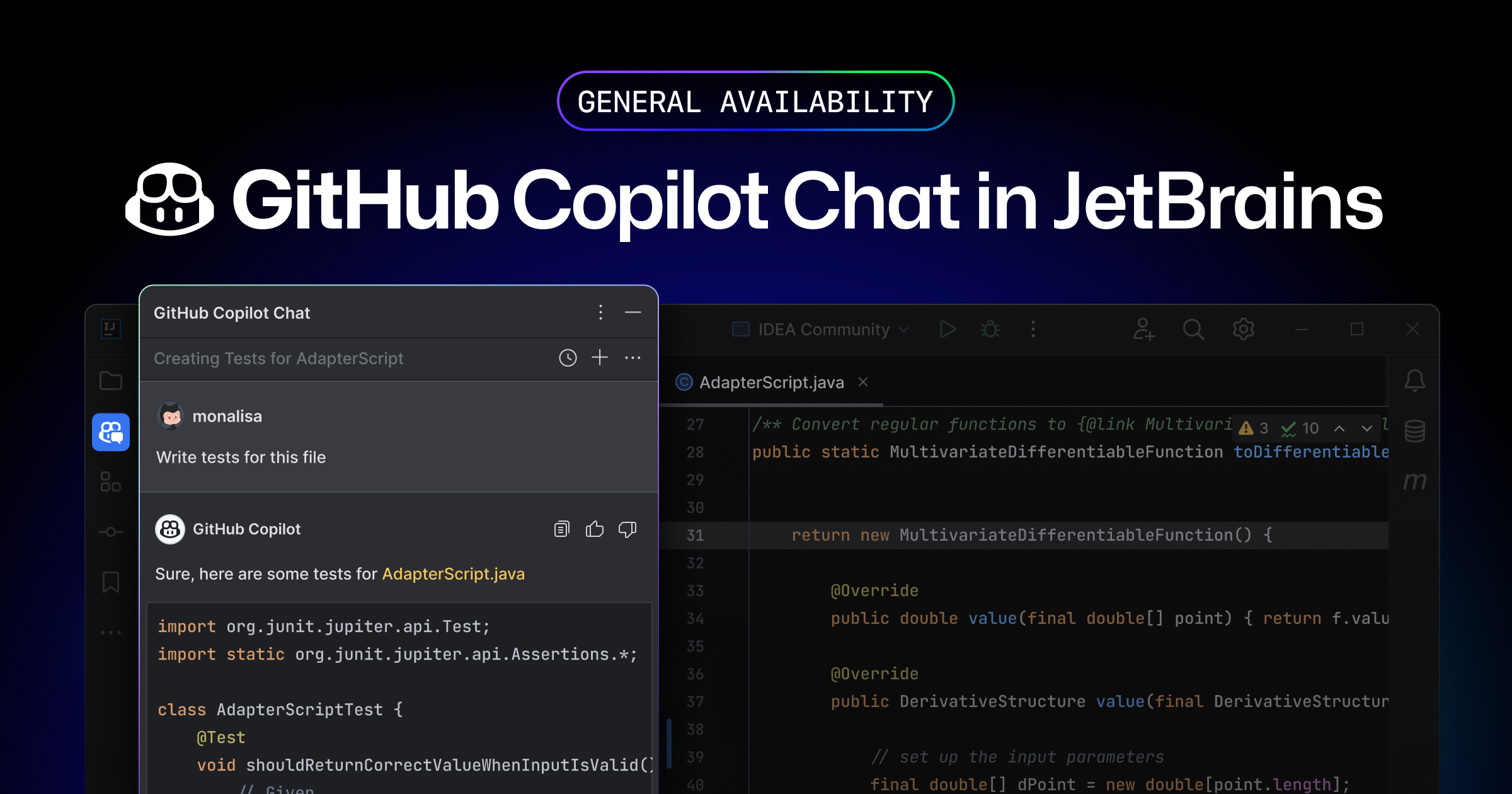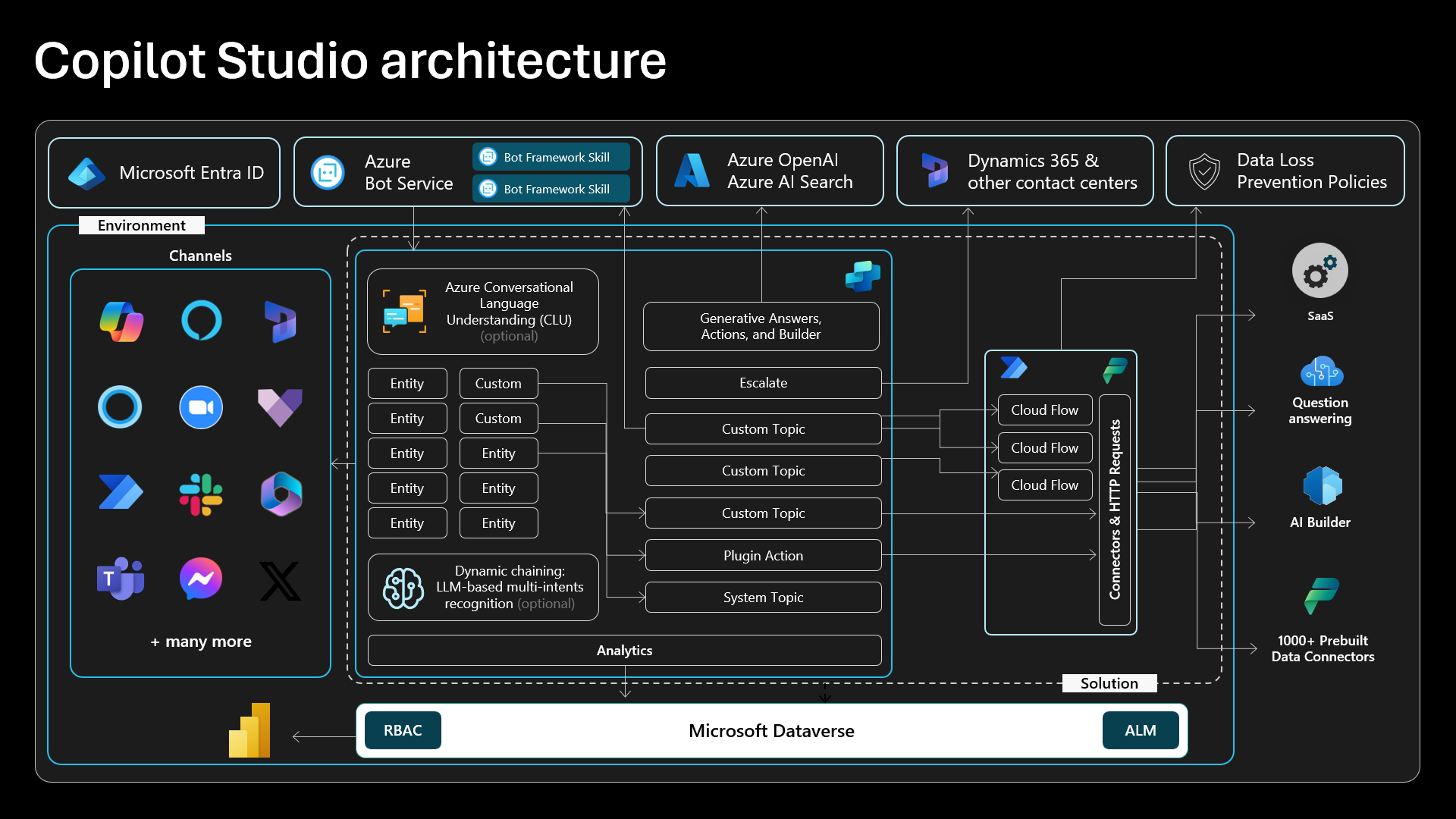Elena Canorea
Communications Lead
Intro
2.Intro
In today’s technology landscape, AI has opened up a new paradigm and initiated new models and ways of working. We are at a time of new opportunities to integrate innovative features into existing software.
One of the most interesting applications for this is Copilot systems, which use artificial intelligence to assist users in a variety of activities, from programming to writing documents, emails, and all kinds of content. We explain the differences, benefits, and features of the different types of Copilot.
The use of tools such as Copilot has led to a significant increase in productivity and work efficiency for users who have already introduced them into their daily routines.
Copilot is already an ally for developers, as well as a very useful AI tool to improve productivity within the Microsoft 365 ecosystem. It integrates seamlessly with the most used applications of this suite, such as Word, Excel, PowerPoint, Outlook, or Teams.
This deep integration allows Copilot to analyze the context of the project or documents you are working on and offer intelligent suggestions in real-time.
Microsoft 365 Copilot can help you write a complex document in a simple way. The AI analyses your writing style, the tone of the document, and any relevant elements to come up with complex sentences or entire sections of text. This feature speeds up the drafting of content in documents, emails, or Teams messages, minimizing the time and effort required.
In addition, Microsoft Copilot harnesses the power of AI to access and contextualize any existing data in MS365. It can analyze texts and extract relevant data, avoiding manual searches and ensuring consistency within the 365 ecosystems.
Another strength of Microsoft Copilot is its ability to learn from each user’s work style. It uses AI to analyze previous activities, anticipating needs and proposing increasingly relevant and personalized suggestions over time.

GitHub Copilot is also a tool that uses the power of AI to help developers when writing and editing code.
Its great strength lies in the powerful AI that underpins it, which is trained on a large amount of open-source code hosted on GitHub, and which is able to understand the context and best practices of the programming language being used. As a result, it offers a range of functions that go far beyond simple code suggestions.
One of its main advantages is automatic code generation. By describing the desired function through comments written in natural language, the developer can have GitHub Copilot automatically generate complete blocks of functional code. This feature is especially useful for speeding up the development of repetitive, standard code or for quick and easy testing of new ideas.
In addition, it can intelligently finalize code. It analyses the surrounding context and the best practices of the programming language used to automatically complete partially written lines of code. This minimizes syntax errors and increases the speed of development, making it easier for the professional to focus on program logic rather than syntax.
Finally, one of its main advantages is its ability to search and explain code, as it allows searching within a large open-source database to find examples and solutions already implemented. This, as well as providing clear and simple explanations of the functionality of a code once it has been analyzed, facilitates the understanding of its base, as well as its maintenance and future developments.
To maximize the potential of AI for software development and productivity, it is essential to understand the differences between the different tools and choose the one that best suits your needs. Both harness the power of AI to offer a wide range of functionalities that optimize developer efficiency and productivity. But there are differences.

GitHub Copilot focuses on helping developers with coding tasks, so its main function is to assist in the development process by providing relevant coding suggestions.
Microsoft 365 Copilot is designed to improve productivity in daily work tasks. Therefore, its main functionality is aimed at improving efficiency in work applications.
Unlike Microsoft Copilot, which integrates with the Microsoft 365 suite, GitHub Copilot operates within specific development software. Available as a downloadable extension for popular text editors such as Visual Studio Code, Vim, Azure Data Studio, and the entire JetBrains IDE suite, GitHub Copilot adapts to the developer’s preferred workflow, maximizing efficiency and productivity during programming.
Therefore, Microsoft Copilot offers greater integration, and GitHub Copilot offers greater flexibility and compatibility.
Both tools offer similar features such as suggestions, auto-completion, and refactoring, but Microsoft Copilot excels in its ability to create textual content, such as generating documents, emails, and presentations.
GitHub Copilot, on the other hand, is more notable for its code search and explanation functions, making it easier to understand and extend open-source databases.
The way users interact with each tool also changes. While GitHub Copilot has a chat feature that allows professionals to interact with the AI conversationally in natural language, Microsoft Copilot relies primarily on contextual suggestions and automatic completion.

Microsoft Copilot can help managers complete projects on time, within scope, and to the highest quality standards. You can organize meetings, summarise discussions, formulate action items in Teams, or use Planner to generate tasks and assign deadlines. You can even manage and track by providing information on workload, progress, and team priorities.
GitHub Copilot accelerates project delivery by up to 55%. It reduces repetitive programming tasks by leveraging existing solutions, reusable components, and public code, and can help formulate Git commit requests and commit descriptions to streamline code reviews and improve collaboration.
Both tools offer support for a wide range of languages (Python, Java, C++, JavaScript, Typescript, etc.), but do not do so in the same way.
Microsoft Copilot has tighter integration with languages such as C# and F#, which are commonly used in .NET application development.
GitHub Copilot, on the other hand, thanks to its open-source nature, has deeper support for other languages such as Go, Rust, and Kotlin, which may be less common in the Microsoft ecosystem.
Both tools feature recurring updates in the extension of language support. The main difference is that GitHub Copilot benefits from contributions from the developer community, which can propose further additions of new languages or improved support for existing ones.
We could not close the article without mentioning another of the most important Copilot: Microsoft Copilot Studio, which incorporates virtual agents, extending the capabilities to develop solutions with little or no code. As such, it has positioned itself as an affordable and versatile option for companies looking to leverage AI for a variety of tasks and workflows.
One of its key strengths is its ability to help organizations create AI assistants tailored to their specific needs, whether it’s automating repetitive tasks or creating AI assistants for specialized functions such as customer service and HR management, improving operational efficiency and productivity.
It is designed to be easy to use, allowing people without extensive coding skills to create AI tools, and democratizing access to a wider range of users.
This tool therefore helps overcome key challenges affecting companies’ operations, drives scalability, fosters innovation, and is integrable with existing systems.

The adoption of any of the Copilot tools also involves several governance challenges. Because they are so easy to use, they can present oversight and compliance problems.
Ensuring that AI tools are used responsibly and in compliance with regulatory requirements is critical to avoid legal repercussions and maintain business integrity.
Therefore, it is very important to conduct regular audits to identify any deviations from policies and regulations. Policies outlining good usage practices and compliance requirements should also be implemented to educate employees and ensure compliance.
It is essential to protect sensitive data and anticipate unauthorized access and potential breaches.
Companies must ensure that AI tools process data in accordance with privacy laws and internal policies, preventing data leaks and unauthorized access.
This access control will limit who can create, modify, and use AI assistants.
Giving visibility into the creation and use of AI assistants is critical to prevent misuse or unintended consequences. To this end, real-time monitoring can help identify potential security threats or misuse in advance.
To this end, a governance framework should be established that defines who is responsible for monitoring AI use, which will help manage compliance and address any issues.
The choice of one tool or another depends on your specific needs and preferences. You will need to consider your specific needs, business context, and existing team workflows.
If you are looking for deeper integration with Microsoft products and a familiar interface, Microsoft Copilot will be the best choice. If you’re looking for more flexibility, programming support, and the ability to interact with an AI in a conversational format, GitHub Copilot will suit you better.
But there is a third possibility. If you’re still not sure which of the two would benefit your business the most or don’t know where to start, Plain Concepts has the solution. Both Copilot tools are an excellent opportunity to increase efficiency, lighten repetitive workloads, stimulate creativity, and give your business a competitive edge.
However, the effectiveness of any generative AI tool depends on how well it fits into your existing systems, workflows, and data.
At Plain Concepts we specialize in incorporating and empowering your business applications with large-scale artificial intelligence. We have designed a unique OpenAI Framework to ensure the correct application of these services, improving process efficiency, meeting production needs, increasing business-critical security, and enhancing regional compliance and availability.
If you want to learn more about which use cases best suit your business goals or how to leverage the capabilities of OpenAI models in your business, we help you unlock the full potential of generative AI!
Elena Canorea
Communications Lead
| Cookie | Duration | Description |
|---|---|---|
| __cfduid | 1 year | The cookie is used by cdn services like CloudFare to identify individual clients behind a shared IP address and apply security settings on a per-client basis. It does not correspond to any user ID in the web application and does not store any personally identifiable information. |
| __cfduid | 29 days 23 hours 59 minutes | The cookie is used by cdn services like CloudFare to identify individual clients behind a shared IP address and apply security settings on a per-client basis. It does not correspond to any user ID in the web application and does not store any personally identifiable information. |
| __cfduid | 1 year | The cookie is used by cdn services like CloudFare to identify individual clients behind a shared IP address and apply security settings on a per-client basis. It does not correspond to any user ID in the web application and does not store any personally identifiable information. |
| __cfduid | 29 days 23 hours 59 minutes | The cookie is used by cdn services like CloudFare to identify individual clients behind a shared IP address and apply security settings on a per-client basis. It does not correspond to any user ID in the web application and does not store any personally identifiable information. |
| _ga | 1 year | This cookie is installed by Google Analytics. The cookie is used to calculate visitor, session, campaign data and keep track of site usage for the site's analytics report. The cookies store information anonymously and assign a randomly generated number to identify unique visitors. |
| _ga | 1 year | This cookie is installed by Google Analytics. The cookie is used to calculate visitor, session, campaign data and keep track of site usage for the site's analytics report. The cookies store information anonymously and assign a randomly generated number to identify unique visitors. |
| _ga | 1 year | This cookie is installed by Google Analytics. The cookie is used to calculate visitor, session, campaign data and keep track of site usage for the site's analytics report. The cookies store information anonymously and assign a randomly generated number to identify unique visitors. |
| _ga | 1 year | This cookie is installed by Google Analytics. The cookie is used to calculate visitor, session, campaign data and keep track of site usage for the site's analytics report. The cookies store information anonymously and assign a randomly generated number to identify unique visitors. |
| _gat_UA-326213-2 | 1 year | No description |
| _gat_UA-326213-2 | 1 year | No description |
| _gat_UA-326213-2 | 1 year | No description |
| _gat_UA-326213-2 | 1 year | No description |
| _gid | 1 year | This cookie is installed by Google Analytics. The cookie is used to store information of how visitors use a website and helps in creating an analytics report of how the wbsite is doing. The data collected including the number visitors, the source where they have come from, and the pages viisted in an anonymous form. |
| _gid | 1 year | This cookie is installed by Google Analytics. The cookie is used to store information of how visitors use a website and helps in creating an analytics report of how the wbsite is doing. The data collected including the number visitors, the source where they have come from, and the pages viisted in an anonymous form. |
| _gid | 1 year | This cookie is installed by Google Analytics. The cookie is used to store information of how visitors use a website and helps in creating an analytics report of how the wbsite is doing. The data collected including the number visitors, the source where they have come from, and the pages viisted in an anonymous form. |
| _gid | 1 year | This cookie is installed by Google Analytics. The cookie is used to store information of how visitors use a website and helps in creating an analytics report of how the wbsite is doing. The data collected including the number visitors, the source where they have come from, and the pages viisted in an anonymous form. |
| attributionCookie | session | No description |
| cookielawinfo-checkbox-analytics | 1 year | Set by the GDPR Cookie Consent plugin, this cookie is used to record the user consent for the cookies in the "Analytics" category . |
| cookielawinfo-checkbox-necessary | 1 year | This cookie is set by GDPR Cookie Consent plugin. The cookies is used to store the user consent for the cookies in the category "Necessary". |
| cookielawinfo-checkbox-necessary | 11 months | This cookie is set by GDPR Cookie Consent plugin. The cookies is used to store the user consent for the cookies in the category "Necessary". |
| cookielawinfo-checkbox-necessary | 11 months | This cookie is set by GDPR Cookie Consent plugin. The cookies is used to store the user consent for the cookies in the category "Necessary". |
| cookielawinfo-checkbox-necessary | 1 year | This cookie is set by GDPR Cookie Consent plugin. The cookies is used to store the user consent for the cookies in the category "Necessary". |
| cookielawinfo-checkbox-non-necessary | 11 months | This cookie is set by GDPR Cookie Consent plugin. The cookies is used to store the user consent for the cookies in the category "Non Necessary". |
| cookielawinfo-checkbox-non-necessary | 11 months | This cookie is set by GDPR Cookie Consent plugin. The cookies is used to store the user consent for the cookies in the category "Non Necessary". |
| cookielawinfo-checkbox-non-necessary | 11 months | This cookie is set by GDPR Cookie Consent plugin. The cookies is used to store the user consent for the cookies in the category "Non Necessary". |
| cookielawinfo-checkbox-non-necessary | 1 year | This cookie is set by GDPR Cookie Consent plugin. The cookies is used to store the user consent for the cookies in the category "Non Necessary". |
| cookielawinfo-checkbox-performance | 1 year | Set by the GDPR Cookie Consent plugin, this cookie is used to store the user consent for cookies in the category "Performance". |
| cppro-ft | 1 year | No description |
| cppro-ft | 7 years 1 months 12 days 23 hours 59 minutes | No description |
| cppro-ft | 7 years 1 months 12 days 23 hours 59 minutes | No description |
| cppro-ft | 1 year | No description |
| cppro-ft-style | 1 year | No description |
| cppro-ft-style | 1 year | No description |
| cppro-ft-style | session | No description |
| cppro-ft-style | session | No description |
| cppro-ft-style-temp | 23 hours 59 minutes | No description |
| cppro-ft-style-temp | 23 hours 59 minutes | No description |
| cppro-ft-style-temp | 23 hours 59 minutes | No description |
| cppro-ft-style-temp | 1 year | No description |
| i18n | 10 years | No description available. |
| IE-jwt | 62 years 6 months 9 days 9 hours | No description |
| IE-LANG_CODE | 62 years 6 months 9 days 9 hours | No description |
| IE-set_country | 62 years 6 months 9 days 9 hours | No description |
| JSESSIONID | session | The JSESSIONID cookie is used by New Relic to store a session identifier so that New Relic can monitor session counts for an application. |
| viewed_cookie_policy | 11 months | The cookie is set by the GDPR Cookie Consent plugin and is used to store whether or not user has consented to the use of cookies. It does not store any personal data. |
| viewed_cookie_policy | 1 year | The cookie is set by the GDPR Cookie Consent plugin and is used to store whether or not user has consented to the use of cookies. It does not store any personal data. |
| viewed_cookie_policy | 1 year | The cookie is set by the GDPR Cookie Consent plugin and is used to store whether or not user has consented to the use of cookies. It does not store any personal data. |
| viewed_cookie_policy | 11 months | The cookie is set by the GDPR Cookie Consent plugin and is used to store whether or not user has consented to the use of cookies. It does not store any personal data. |
| VISITOR_INFO1_LIVE | 5 months 27 days | A cookie set by YouTube to measure bandwidth that determines whether the user gets the new or old player interface. |
| wmc | 9 years 11 months 30 days 11 hours 59 minutes | No description |
| Cookie | Duration | Description |
|---|---|---|
| __cf_bm | 30 minutes | This cookie, set by Cloudflare, is used to support Cloudflare Bot Management. |
| sp_landing | 1 day | The sp_landing is set by Spotify to implement audio content from Spotify on the website and also registers information on user interaction related to the audio content. |
| sp_t | 1 year | The sp_t cookie is set by Spotify to implement audio content from Spotify on the website and also registers information on user interaction related to the audio content. |
| Cookie | Duration | Description |
|---|---|---|
| _hjAbsoluteSessionInProgress | 1 year | No description |
| _hjAbsoluteSessionInProgress | 1 year | No description |
| _hjAbsoluteSessionInProgress | 1 year | No description |
| _hjAbsoluteSessionInProgress | 1 year | No description |
| _hjFirstSeen | 29 minutes | No description |
| _hjFirstSeen | 29 minutes | No description |
| _hjFirstSeen | 29 minutes | No description |
| _hjFirstSeen | 1 year | No description |
| _hjid | 11 months 29 days 23 hours 59 minutes | This cookie is set by Hotjar. This cookie is set when the customer first lands on a page with the Hotjar script. It is used to persist the random user ID, unique to that site on the browser. This ensures that behavior in subsequent visits to the same site will be attributed to the same user ID. |
| _hjid | 11 months 29 days 23 hours 59 minutes | This cookie is set by Hotjar. This cookie is set when the customer first lands on a page with the Hotjar script. It is used to persist the random user ID, unique to that site on the browser. This ensures that behavior in subsequent visits to the same site will be attributed to the same user ID. |
| _hjid | 1 year | This cookie is set by Hotjar. This cookie is set when the customer first lands on a page with the Hotjar script. It is used to persist the random user ID, unique to that site on the browser. This ensures that behavior in subsequent visits to the same site will be attributed to the same user ID. |
| _hjid | 1 year | This cookie is set by Hotjar. This cookie is set when the customer first lands on a page with the Hotjar script. It is used to persist the random user ID, unique to that site on the browser. This ensures that behavior in subsequent visits to the same site will be attributed to the same user ID. |
| _hjIncludedInPageviewSample | 1 year | No description |
| _hjIncludedInPageviewSample | 1 year | No description |
| _hjIncludedInPageviewSample | 1 year | No description |
| _hjIncludedInPageviewSample | 1 year | No description |
| _hjSession_1776154 | session | No description |
| _hjSessionUser_1776154 | session | No description |
| _hjTLDTest | 1 year | No description |
| _hjTLDTest | 1 year | No description |
| _hjTLDTest | session | No description |
| _hjTLDTest | session | No description |
| _lfa_test_cookie_stored | past | No description |
| Cookie | Duration | Description |
|---|---|---|
| loglevel | never | No description available. |
| prism_90878714 | 1 month | No description |
| redirectFacebook | 2 minutes | No description |
| YSC | session | YSC cookie is set by Youtube and is used to track the views of embedded videos on Youtube pages. |
| yt-remote-connected-devices | never | YouTube sets this cookie to store the video preferences of the user using embedded YouTube video. |
| yt-remote-device-id | never | YouTube sets this cookie to store the video preferences of the user using embedded YouTube video. |
| yt.innertube::nextId | never | This cookie, set by YouTube, registers a unique ID to store data on what videos from YouTube the user has seen. |
| yt.innertube::requests | never | This cookie, set by YouTube, registers a unique ID to store data on what videos from YouTube the user has seen. |
